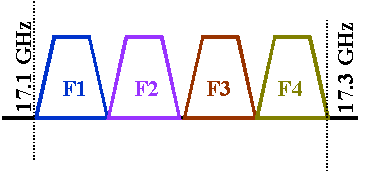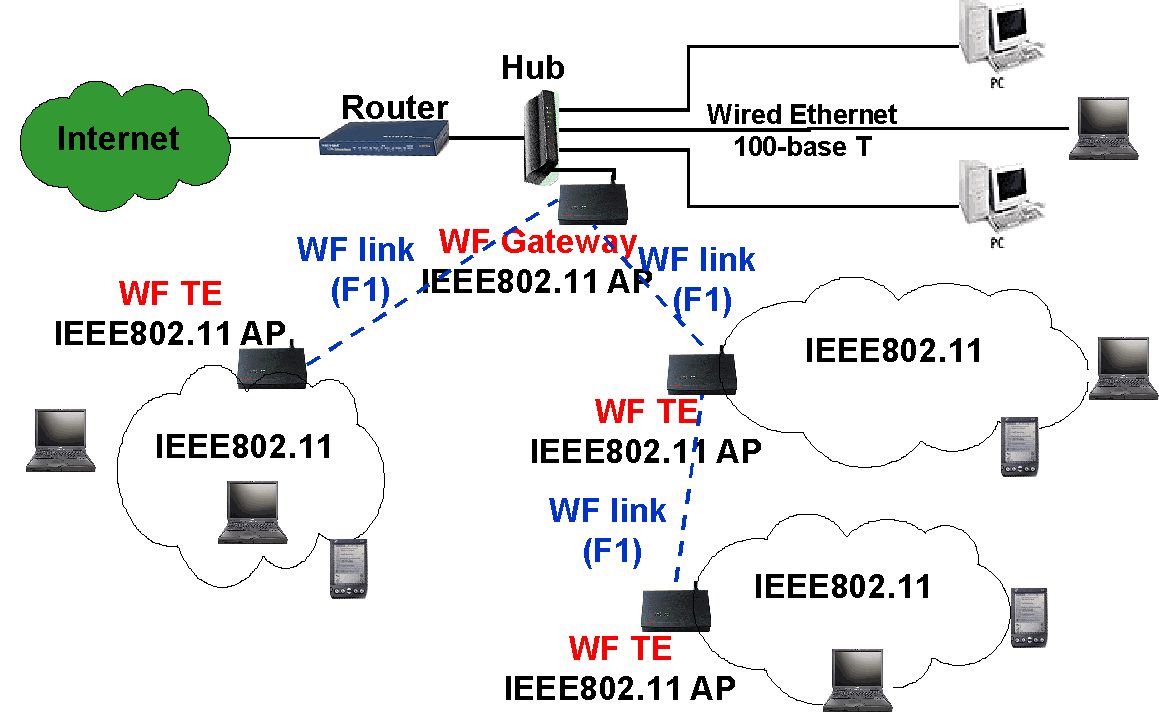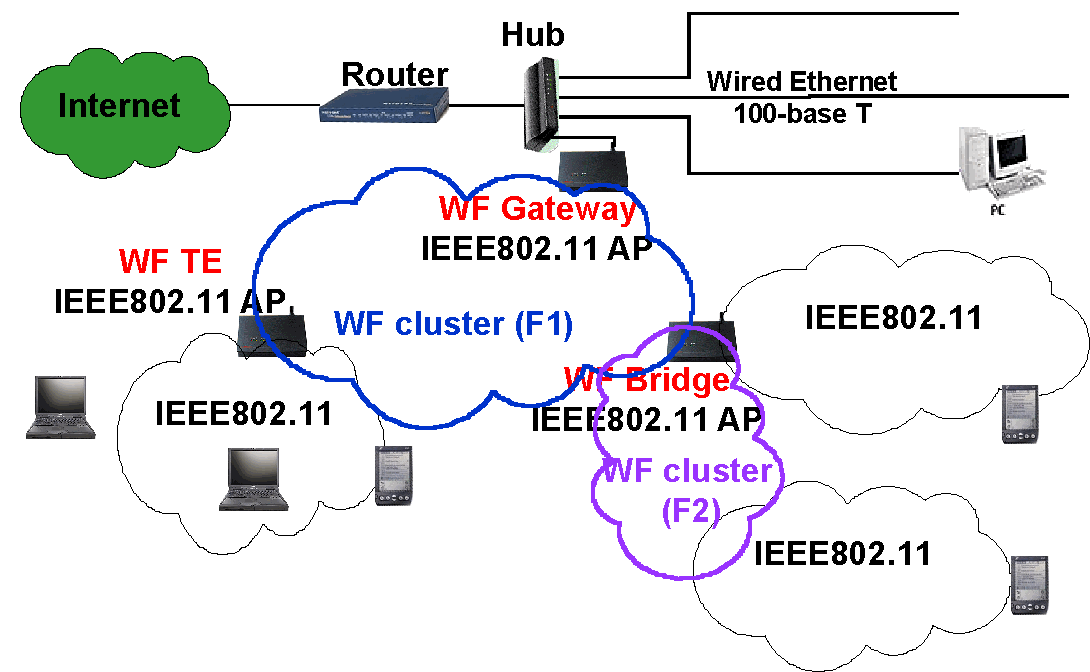

|
Wireless CommunicationChapter: Network Concepts and
Standards
|
In recent years there has been a growing trend towards personal computers and workstations becoming "portable" and "mobile". This ever-increasing group of mobile users has been demanding access to network services similar to their "tethered" counterparts. Today many people carry numerous portable devices, such as laptops, mobile phones, PDAs and mp3 players, for use in their professional and private lives. For the most part, these devices are used separately that means their applications do not interact, but at the same time numerous factors associated with technology, business, regulation and social behavior naturally have led to a big expansion of wireless networking, which is advancing in terms of technology and usage/penetration, thanks to the Internet and the success of second-generation cellular systems.
Table 1 summarizes the main features of the current wireless technologies and compared to WIND-FLEX ones.
|
802.11b |
802.11a |
Bluetooth |
HIPERLAN/2 |
WIND-FLEX |
|
|
Carrier |
2.4 GHz |
5 GHz |
2.4 GHz |
5 GHz |
17 GHz |
|
Bandwidth |
22MHz (DSSS) |
20 MHz |
1 MHz per channel |
20 MHz |
50 MHz |
|
Max physical rate |
Up to 11 Mbps |
Up to 72 Mbps |
1 Mb/s |
72 Mb/s |
215 Mbps |
|
Medium Access Control |
CSMA/CA RTS/CTS |
CSMA/CA RTS/CTS |
TDMA/FDMA TDD |
TDMA/TDD |
TDMA/TDD |
|
Frequency Selection |
DSSS |
OFDM |
FHSS |
OFDM |
A-OFDM |
|
Modulation |
QPSK |
BPSK/QPSK 16QAM/64QAM |
GFSK |
BPSK/QPSK/ 16QAM |
BPSK/4QAM 16QAM/64QAM |
|
Cell radius |
<30,50,70m |
<50m |
<10m |
<30m |
<100(LOS), <10m (NLOS) |
Table 1. WLANs standards
The goal of the WLAN standard is connectivity to the Ethernet plug in the wall at the workplace and Ethernet-like connectivity in ad hoc situations, such as conferences. Devices that attach to the Ethernet are usually high-capability devices, such as laptops and desktop computers. These devices are relatively expensive and wireless connectivity is justifiable for business entities as an infrastructure cost. The main WLAN technologies are currently the IEEE 802.11 standard, which is already available on the market in its b version, and HIPERLAN/2 standard.
IEEE802.11 and HIPERLAN type 2 Characteristics
An 802.11 WLAN is based on a cellular architecture where the system is subdivided into cells, where each cell, called Basic Service Set (BSS), is controlled by a Base Station, called Access Point (AP). Most installations are formed by several cells, where the Access Points are connected through some kind of backbone (called Distributed System or DS), typically Ethernet or wireless itself. The basic MAC mechanism specified in IEEE802.11 is A Distributed Coordination Function (DCF) that allows for sharing of the wireless channel through the use of carrier sense multiple access with collision avoidance (CSMA/CA). A CSMA/CA protocol works as follows: a station desiring to transmit senses the medium, if the medium is busy then the station will defer its transmission to a later time, if the medium is sensed free then the station is allowed to transmit. The station transmits a short control packet called RTS (Request to Send), which will include the source, destination, and the duration of the following transaction, the destination station will respond (if the medium is free) with a response control Packet called CTS (Clear to Send), which will include the same duration information. All the stations receiving either the RTS and/or the CTS, will set their Virtual Carrier Sense indicator, for the given duration, and will use this information together with the Physical Carrier Sense when sensing the medium. This kind of protocols are very effective when the medium is not heavily loaded, since it allows stations to transmit with minimum delay, but there is always a chance of stations transmitting at the same time, caused by the fact that the station sensed the medium free and decided to transmit at once. So in general a MAC mechanism that uses TDMA, such as the WIND FLEX system, offers better performance.
HIPERLAN/2 is a standard for high-speed radio communication system (air interface speed up to 72 Mbit/s) to provide short-range wireless access to various broadband core networks in the 5 GHz band. The standard defines core network independent Physical (PHY) and Data Link Control (DLC) layers as well as a set of core network specific Convergence Layers (CL) on top of the DLC layer. HIPERLAN/2 is a cellular system where each radio cell is controlled by an Access Point (AP) covering a certain geographical area. The system can be deployed both indoor and outdoor. The access scheme is TDMA
Wireless Personal Area Networks
The goal of WPANs is replacing wires between objects that are close to each other. While the WLAN technologies are specifically designed for devices in and around the office or home, a WPAN device will travel from country to country, be used in cars, airplanes, and is designed for international use allowing PCs, PDAs, mobile phones, pagers, and other handheld devices to communicate and interoperate with one another. A WPAN technology is characterised by short-range, low power, low cost, small networks. Currently the main WPAN technology is Bluetooth.
The Bluetooth’s architecture is very similar to the WIND-FLEX’s one: two or more units sharing the same channel form a piconet. There is one master unit and up to seven active slave units in a piconet. These devices can be in either of the states: active, park, hold and sniff. Multiple piconets with overlapping coverage areas form a scatternet.
Recently a committee was created by the Institute of Electrical and Electronics Engineers (IEEE) to develop a new standard called 802.15 Wireless Personal Area Networks (WPAN); the goal of publishing the 802.15 standards will be to accommodate wider adoption and applicability, and to deal with issues like coexistence and interoperability within the networks. Established in January 1999, the WPAN working group, which is part of the Local and Metropolitan Area Network Standards Committee of IEEE, has formed four task groups, each focused on necessary standards, one of these has the scope of publishing a new standard for high data rate for WPAN, this data rate could reach 20 Mbit/sec. The Bluetooth Special Interest Group (SIG) specification serves as the foundation for developing the IEEE 802.15 WPAN standard, which would standardize the Medium Access Control (MAC) and Physical (PHY) layers of Bluetooth. The group has accepted significant parts of the Bluetooth specification without modification and has enriched it with various other features and considerations.
WIND-FLEX as a High-Speed Wireless LAN Backbone
The WIND-FLEX adaptive modem architecture can be used as a Wireless Local Area Network or Wireless Personal Area Network backbone. The WLAN backbone solution provides an efficient data transfer and Internet access from common mobile WLAN terminals. Currently IEEE802.11b and IEEE802.11a are the dominant standards for WLAN systems, thus the backbone should be able to support connections from IEEE802.11 standard based devices.
The WIND-FLEX system provides either multichannel or single channel backbone network. The WIND-FLEX frequency band (17.1 GHz – 17.3 GHz) can be divided up to four channels in order to arrange separate network structures. The other possibility is to arrange a single channel, multihop backbone network. These solutions open the way for two different backbone scenarios for open space environments like airports and large factory halls.

Figure 8: WIND-FLEX frequency band and Channelisation.
System Overview and Scenarios
Our solution for high speed wireless backbone is based on WIND-FLEX adaptive modem architecture, which is described at WIND-FLEX white paper. The backbone solution requires several WIND-FLEX system adjustments. The current WIND-FLEX target system and network structure is a single hop network with dynamic resource allocation for mobile terminals. In contrary the backbone network uses fixed terminals and it will simplify the system architecture slightly. With omni-directional antennas the WIND-FLEX coverage area is less than 20 meters, but the backbone network utilizes directional antennas and thus the WIND-FLEX backbone link span can be over 100 meters. This makes it possible to enlarge the coverage area
The Single Channel WIND-FLEX Backbone
The following picture represents the single channel WIND-FLEX backbone solution for IEEE802.11 WLAN systems. The network includes WIND-FLEX terminals and Gateways. The WIND-FLEX terminals are wireless access points with IEEE802.11 interfaces and WIND-FLEX (WF) interfaces. The routing between WF and IEEE802.11 is handled at network layer, thus no additional routing mechanisms and adaptivity at lower levels of WIND-FLEX systems is needed.

Figure 9 WIND-FLEX Single Channel Backbone Network.
WF Terminals and IEEE802.11 Access Points
WF Gateway
The Multichannel WIND-FLEX Backbone
The following picture describes the multichannel backbone network. Using the multichannel network the frequency can be fully utilized. Due to that, the solution is more efficient than single channel multihop system what comes to pure network throughput efficiency. However the costs for maintaining and constructing the network are higher than with the single channel backbone network. The network consists of WF gateway, WF terminals and WF bridges between WF clusters.

Figure 10: WIND-FLEX Multichannel Backbone Network.
The WIND-FLEX terminal
The WIND-FLEX bridge
The WIND-FLEX gateway
Impact of Backbone solutions on WIND-FLEX Architecture
RF/IF front-end
For the backbone application, given the fixed nature of installations, the antennas can be even extremely directional thus giving a significant advantage for this application on the coverage ranges.
Very directional and low cost 17 GHz antennas could be developed with microstrip passive phase array, increasing the number of patches as antenna directivity increases.
Baseband
For these specific applications, given the fixed nature of links and the LOS guaranteed visibility among radios, the baseband can be simplified as all adaptive controls and features are not needed or can be heavily simplified in their dynamic actions.
MAC/DLC
The MAC and DLC part for this specific application are a simplified version of current WIND-FLEX ones, particularly because many functions can be performed only at the network set-up phase. For instance system initialization needs to be performed only once, the roles of master and slave devices are fixed, terminals are always on, working channels are selected during the network configuration phase, association procedures are also performed only once since the WF addresses are fixed. The disassociation procedure is needed only when network is closed down.
Security issues
The Internet security issues should be taken into consideration with WIND-FLEX backbone network too. Network attacks can be divided into the following classic categories:
Most common types of attacks are currently the data capturing and finally seizuring the target device. After the seizuring of unprotected device the device can be used for further attacks or the valuable information such as user statistics, password information etc. can be captured. Wireless systems, in which the air interface and channel are open for everyone to listen to, the possibility for successful network attack is higher than with wired network. However most of the problems can be fixed in WIND-FLEX backbone network with already existing solutions for networks, which are using Internet protocol e.g. IPv6 with IPsec in order to guarantee the sufficient security.